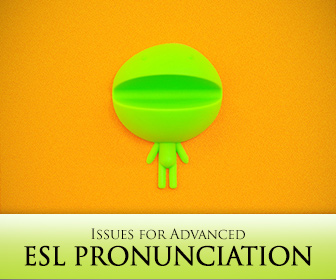Almost There, Continued Refinement: Issues for Advanced ESL Pronunciation


In a way, this is great: students in such classes are usually advanced and motivated. But this is also the problem: with such a narrow focus to the curriculum and with students who are already advanced, what do you even do with them all class session, much less all term? Not to worry: there is an abundance of material and skills to teach even advanced ESL students in a pronunciation/accent reduction class.

Even advanced students will often need work on syllable and word stress: I find students who are perfectly comprehensible in English and have large vocabularies have some difficulty in knowing which syllable is stressed in multisyllabic words. Actually this can be a problem for native speakers as well, knowing a word in their written vocabulary but being unsure of how to pronounce it, especially which syllables receive stress, and therefore avoiding using the word in speaking. Teaching syllable and word stress in multisyllabic words can be done by giving students a high-interest reading on an academic topic and picking out words to study and learn how to pronounce with correct stress. This will also lead to additional processing of those words, which will lead to an increased chance of actually acquiring them.
Again, even advanced students often can use work on sentence stress and intonation. In addition, a large part of comprehensibility of speech is how well overall the speaker stresses content words, connects words, and reduces structural or grammar words (the “suprasegmentals" of speech.) Teaching students what to stress and what to reduce and where pitch should rise and fall is therefore very important. This can be done by having students mark the stressed words and syllables in sample dialogues and practicing them; they can also annotate an academic text, marking the stressed and unstressed syllables and rising and falling pitch then practicing reading out loud.
Although the suprasegmentals, the stress and intonation, are important, so are individual speech sounds. Instructors should therefore make a plan to include at least some study of discrete sounds. One way to decide which sounds to include is to assess individual students by taping them at the beginning of the term and then noting particular problems: does the “th” sound, “r” sound, or “l” sound give students difficulty, for example? Or maybe it’s distinguishing “s” and “sh” or “b” and “v” sounds? Usually, you’ll note specific trends in your class, with most students demonstrating difficulty with a particular sound or sounds, so it is that area which should be emphasized in further practice.

Once some areas of study are laid out, then the general direction of the term can be determined. Curriculum elements most courses should include are the following:
Assess as thoroughly as possible. Assess students’ pronunciation of discrete sounds, word and sentence stress, and intonation patterns. Assess by taping students reading aloud, doing a dialogue with a peer, and by giving a short impromptu speech on an everyday topic, like their first day in the United States. Also do a short needs assessment: What brings students to class? What do they want to learn? Do they want to learn English for academic, professional, or social purposes? The skills and needs assessment together should provide enough information to formulate a plan of action for student learning.
Using the information from the assessments, develop a tentative plan of study for the term. In analyzing the assessments, you will probably see common areas of need: most students need to work on sentence stress and intonation, for example, or on vowel sounds. Most are there for professional purposes, for example, or most seem to struggle with the pronunciation of academic vocabulary. The assessment is likely to reveal common patterns among your students in their skills and vocational needs.
Nothing is more discouraging –and boring—than excessive time spent on activities students will never really use, like “tongue twisters.” Even more seemingly “authentic” tasks, such as dictations, are not really so as we don’t often do dictations outside of the classroom.Instead focus on situations where good pronunciation is actually needed and situations where context is reduced and/or speakers can’t rely on the surrounding environment to make meaning clear.
Clear pronunciation is needed in various real-life situations: when giving directions and leaving messages, for example, but also when giving precise, detailed instructions, when speaking before a large group, or when taking part in a small group discussion. In each of these situations, either the context is reduced or the information being conveyed is very detailed with not much room for error, or the speaker is presenting before a large group—all of which make understanding either more difficult or more critical.
Pronunciation, conversation, and language itself occurs in a social context, in groups of people. Therefore, language should be practiced in groups; the students should enter a dialogue with their peers rather than a one-on-one dialogue with the teacher, ignoring the rest of the community, or a monologue with themselves in a language lab. Listening and language in general should not be a solitary process, with the student sitting in front of a computer, listening to taped conversations, as this is not how language actually occurs in any place outside of an academic setting. Rather, students should enter a learning community with their peers, discussing in groups such topics of personal interest as favorite books and movies or of more societal concerns ones as immigration laws. We don’t usually discuss a topic unless it has at least some personal and/or cultural importance. Students therefore should not be confined to bland topics of little personal or professional relevance.
Use the needs assessment to guide you in choice of class materials. For example, if you find most of your students have a need to work on intonation patterns and have an interest in academic English, there are already materials out there to address those needs. Get recommendations from colleagues at school or at meetings on the materials they use for similar classes, or go to a professional organization’s or publisher’s website and search “academic English” and “intonation.” A number of sources will most likely come up. In most cases you may order exam copies or look at sample chapters on the website before making a decision. There is no need to reinvent the wheel; use materials that are known to be effective.
If you know in advance what your typical day is, this is helpful not only for students but also for the you, the instructor. In my pronunciation class, for example, I usually start off with a short lecture/presentation on some concept, such as the intonation on yes/no questions, break students into small groups to practice, and wind up with some independent practice or presentation, with volunteer students showing their work to their peers. Knowing how the day will be structured helps your students in knowing what to expect and how to participate in the class; it also helps the teacher in preparing for the class. If all parties know in general what is coming up next (teacher lecture, small group or partner work, whole class discussion, etc.), there is more possibility to focus on the actual content of the lesson, what is being taught, because they are not distracted wondering what activities are coming next.
However, there are also pitfalls in understanding what to teach students who already seem advanced and which materials to use an how to structure the curriculum. With careful assessment and planning, however, the challenges of an ESL pronunciation class can be addressed and the rewards reaped.